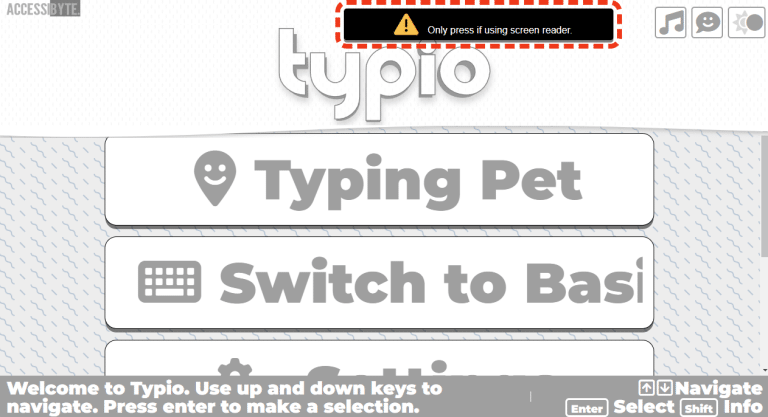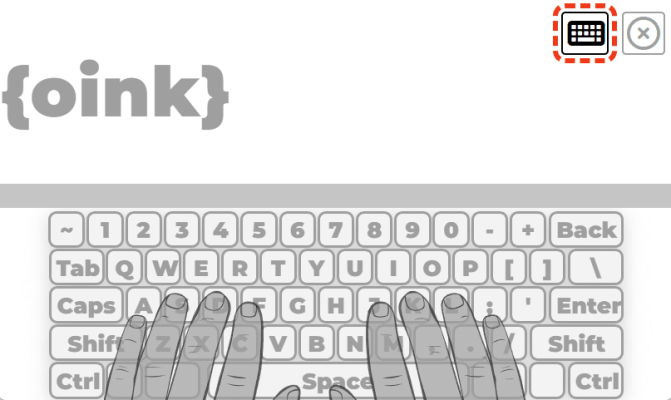How Can We Help?
Using Typio and Braillo with a screen reader
All Accessibyte apps are self-voicing, so no outside screen reading software is required. Typio and Braillio users who want to use their preferred screen reader can rely on the following steps to disable Typio’s included voicing and navigate with their chosen assistive technology.
Enable Screen Reader Mode

- From the Typio main menu, use Button or Tab navigation to reach the ‘Screen Reader Mode Button’. This button isn’t present by default but will appear when you navigate to it.
- Activate the Screen Reader Mode Button and your screen reader will announce that Screen Reader Mode is enabled. From this point forward, Typio’s self-voicing will be disabled and Typio will instead communicate through your screen reader. Screen Reader Mode makes other changes behind the scenes, so be sure to activate it even if you are using assistive technology that doesn’t produce speech. For example, a braille display or special typing input software/hardware.
General Navigation
Button navigation is recommended. For example, pressing ‘B’ on most screen readers will focus the next available button. In Typio, that will navigate through menu options, score screens and more.
Once you reach the desired button, activate it. This is typically done with Space or Enter but may also require special input like a double tap if using VoiceOver.
Typing during lessons

When Screen Reader Mode is enabled, you should automatically be able to type and input text during lessons. If typing produces the desired result, there’s nothing more you need to do.
If typing isn’t being passed through to Typio, you’ll know because typing prompts simply won’t progress. Typio will ask you to type a character, you type it, and either nothing happens or the wrong thing happens. If this is the case, navigate to the Typing Area edit field. Your screen reader will announce it as “Typing Area. Type here.” Depending on your screen reader, you may need to press a key, such as Space or Enter, to activate the typing area.
Some assistive technology besides screen readers may need to activate the on-screen Typing Button. This may be the case if your assistive technology performs pre-processing of text before it reaches an application. For example, a braille display converting braille dots into standard characters. Similarly, some assistive technology will intercept keypresses and perform a custom action instead of the default keypress. For example, the Button Navigation mentioned above changes the typical use of the B key from typing ‘b’ to navigating to the next button element on the page. The Typing Button is intended to work with those custom functions.j
At the start of each lesson there is a “Start Lesson” button. Activating that button with your assistive technology will automatically perform the above steps for you so you can begin typing.
Understanding the typing prompt
Typio will send the next typing prompt to your screen reader automatically after each prompt is typed. You can press Control to repeat the prompt. Screen reader users can also navigate within the typing lesson to focus the typing prompt. This could be done with the left, up or previous navigation key. The typing prompt will be begin with “Now type:”, followed by the text to type.
An example of using a braille device to check the typing prompt then return to typing would be as follows:
- Press the Previous key once or twice, until you hear “Now type: Hello”.
- Press the Next key one or twice until you hear “Typing area. Type here”.
- Press the Enter key to activate the typing area.
- Type the text “Hello”, then press Space to hear the next typing prompt.
Recovering focus
By default, Typio simplifies users navigation to only the needed elements, such as menu options. Assistive Technology may override this and allow users to access elements outside of Typio, such as the address bar or other buttons in the browser. If this happens and a user needs to return focus to Typio, we recommend Tab navigation.
If in a Typio menu, simply Tab until you reach the menu item you want and continue from there as desired. If in a typing lesson or tutorial, Tab until you reach the Typing Button and activate it to return to typing.
Typing Pet games
During Typing Pet games, activating the Start/Next/Done button should automatically place the screen reader where it needs to be to begin typing during the game. If that isn’t the case with your screen reader, take the same steps you would during a typing lesson and navigate to the “Typing Area. Type Here” edit field or Typing Mode button.
Simple Recap
If using assistive technology with Typio or Braillio, do the following:
- On the Typio or Braillio main menu, Use Button or Tab navigation to reach the ‘Screen Reader Mode’ button and activate it.
- Navigate menus by Tab, Button navigation or arrows.
- During typing lessons, you should be able to type when Screen Reader Mode is enabled.
- If you’re not able to type automatically, activating the Start Lesson button should do the trick.
- If you’re using a screen reader, navigating to the ‘Typing Area. Type Here.’ edit field should allow you to type.
- Some assistive technology users will want to activate the Typing Mode button.
- Typing prompts are automatically announced. To hear them again, navigate to the “Now type” element, then navigate back to the “Typing Area. Type here.” element. Moving between those two elements should be all you need to do.
- If you lose focus, navigate to the “Typing Area. Type Here” edit field or Typing Mode button.
- In Typing Pet games, navigate to the “Typing Area. Type Here” edit field or Typing Mode button.
Working together
Providing a consistent, fully accessible experience across all devices, browsers and assistive technologies is challenging. But Accessibyte is up for the challenge!
We respect our users know what they need and often have more experience with their assistive technology of choice than we do. If there’s something we’ve missed or could improve, let us know.
